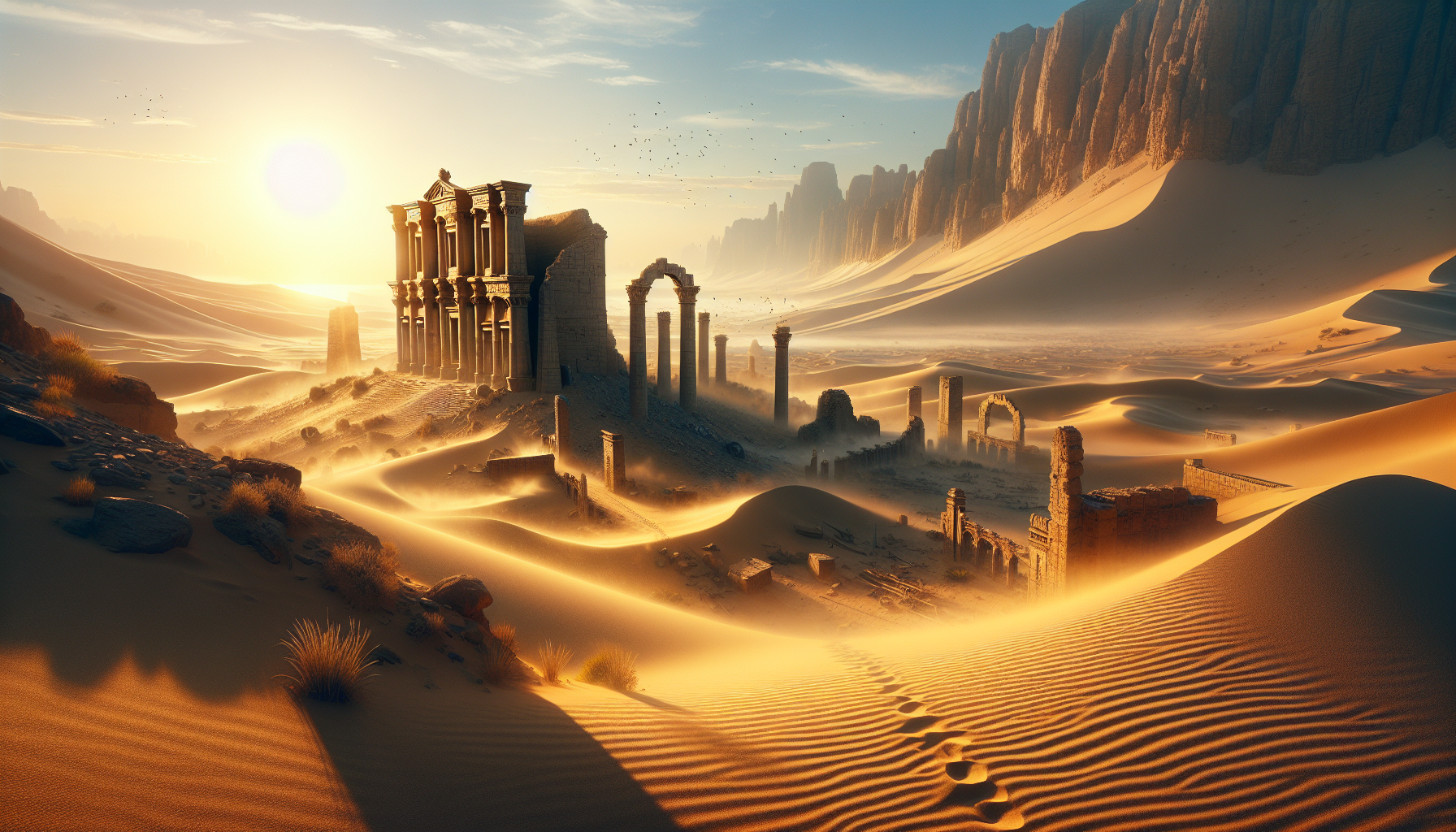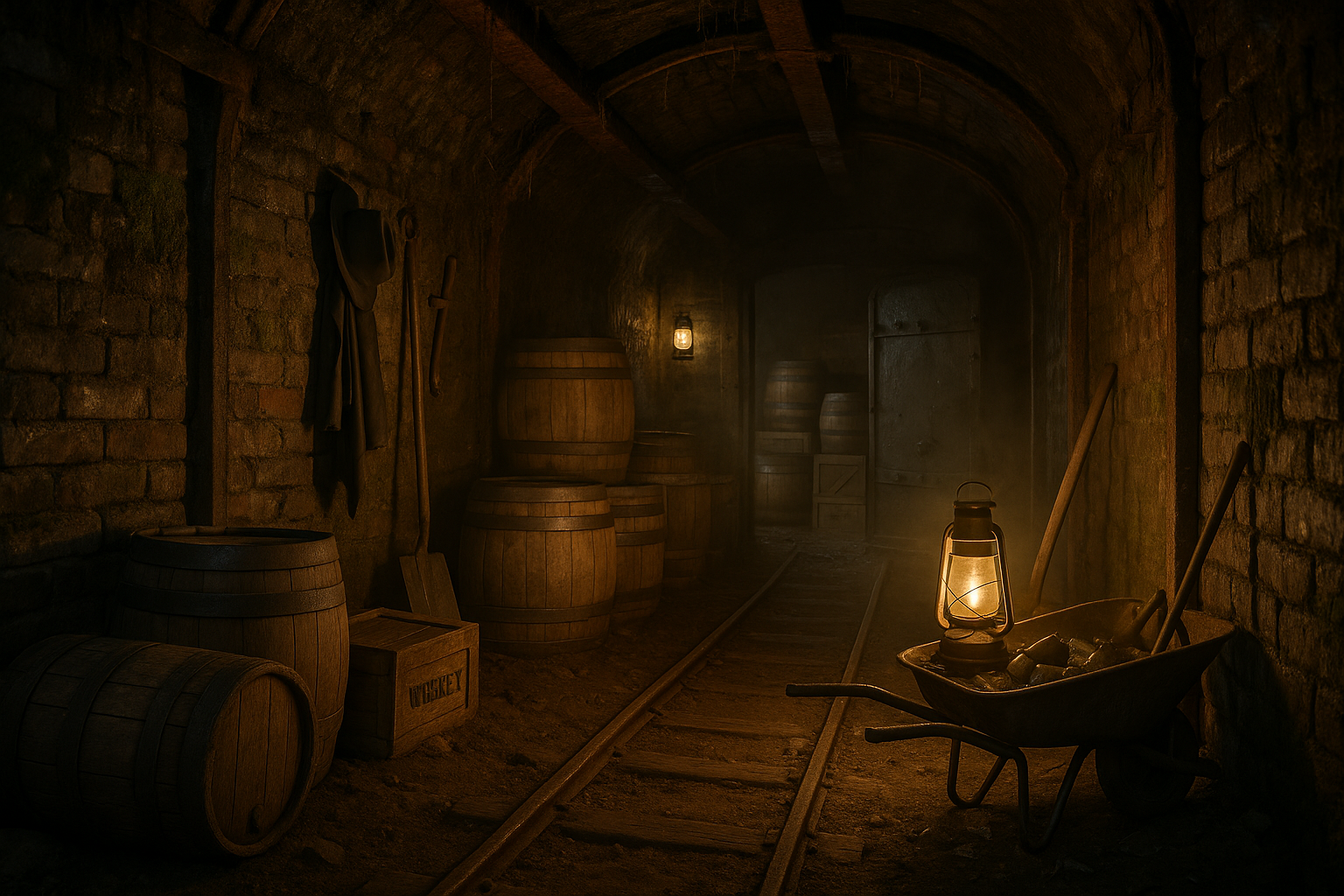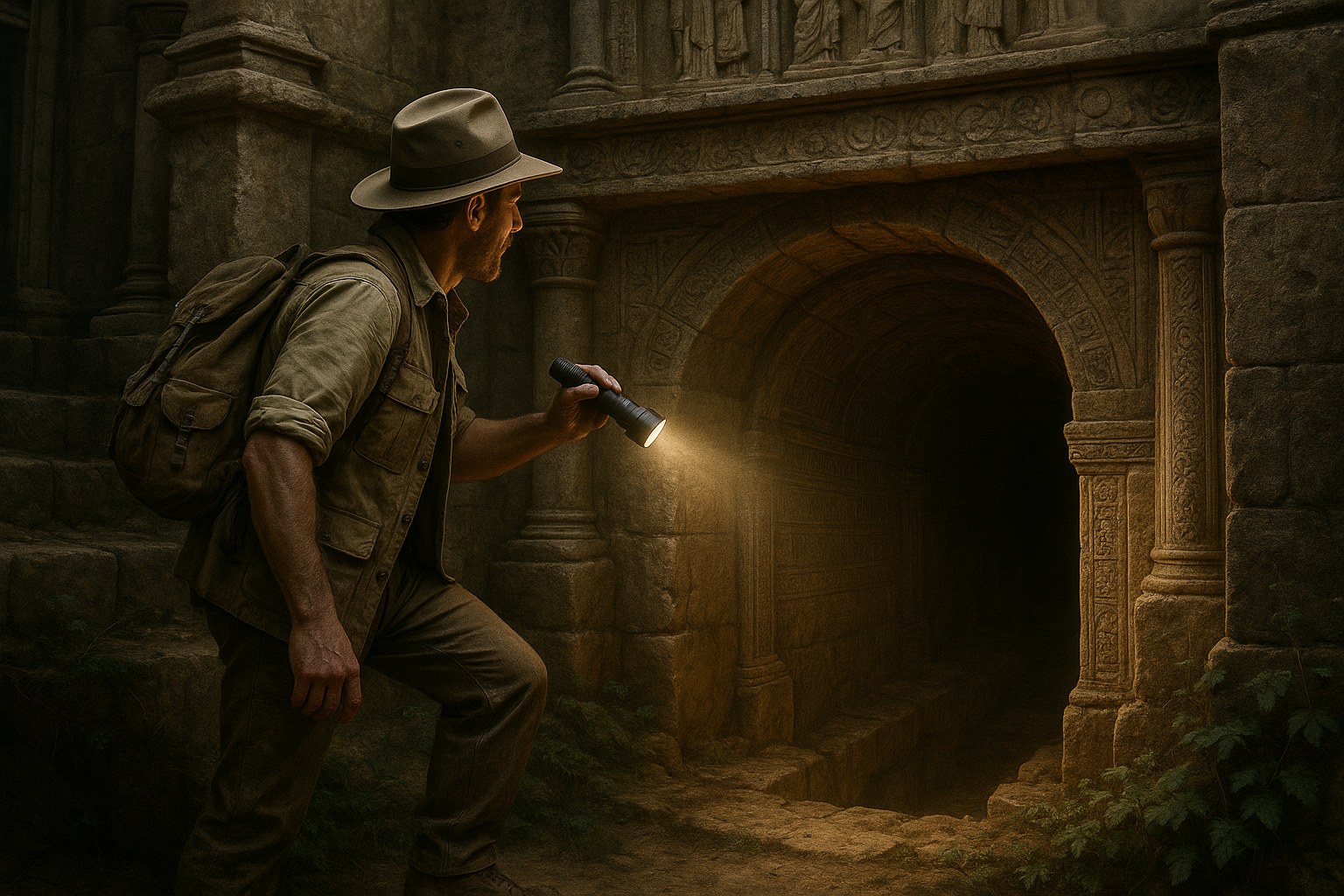Amidst the vast, undulating expanses of the world’s deserts lie secrets as old as time itself, shrouded in mystery and waiting to be uncovered. These barren landscapes, often perceived as desolate and inhospitable, are actually home to some of history’s most intriguing enigmas: the secret cities hidden beneath the sands. Imagine the whispers of ancient civilizations carried by the desert winds, the echoes of bustling markets, grand temples, and vibrant communities that once thrived where now only the resilient dunes remain. These hidden gems of human achievement and resilience offer a captivating glimpse into a past that has long since been buried, inviting modern explorers to delve into their mysteries and uncover the stories etched into the very heart of the earth. 🏜️
In this journey through time, we will embark on an exploration of these forgotten metropolises, venturing beyond the visible horizons to discover the rich tapestry of life that once flourished in these unlikely havens. From the legendary city of Ubar, often dubbed the “Atlantis of the Sands,” to the enchanting remnants of Petra with its rock-cut architecture, we will traverse continents and centuries. Each of these sites offers a unique window into the lives of the people who defied the harsh desert conditions to build thriving societies. What drove them to settle in such unforgiving terrains? How did they adapt to the challenges posed by their environment, and what ultimately led to their decline? These are some of the questions we will seek to answer as we unveil the treasures hidden beneath the sands.
Our exploration will not only focus on the historical and archaeological significance of these cities but will also highlight the modern-day efforts to preserve and study them. Archaeologists, historians, and adventurers from around the globe are drawn to these sites, armed with advanced technology and an insatiable curiosity to piece together the puzzles of the past. We’ll delve into the cutting-edge methods used in the discovery and excavation of these cities, from satellite imaging to ground-penetrating radar, shedding light on how today’s technology is unlocking the secrets of yesterday. Moreover, we’ll discuss the cultural and economic impacts of these discoveries on local communities, examining how the resurgence of interest in these ancient cities is influencing contemporary life and tourism in the surrounding areas.
Join us as we embark on this captivating odyssey across the deserts of the world, from the Middle East to North Africa and beyond. As we lift the veil on these ancient wonders, prepare to be enchanted by tales of ingenuity, survival, and the enduring spirit of human exploration. Whether you are a history enthusiast, a lover of adventure, or simply someone curious about the world, this journey promises to be a rich and rewarding experience. So, dust off your explorer’s hat and let the sands of time reveal their hidden stories, waiting to be discovered and celebrated anew. 🌍✨
The Allure of Desert Treasures
The desert, with its vast, unending sands and mirage-filled horizons, has long been a source of mystery and fascination. For centuries, these arid landscapes have been seen as barren wastelands, devoid of life or significant historical value. However, hidden beneath the seemingly lifeless dunes are secrets that tell stories of ancient civilizations, bustling trade routes, and lost cities. These desert treasures captivate explorers, historians, and adventurers alike, drawing them into a world that is as challenging as it is rewarding.
Unveiling these treasures often requires a combination of modern technology and traditional exploration techniques. Archaeologists and researchers are increasingly using satellite imagery and ground-penetrating radar to locate potential sites of interest. This blend of ancient lore and cutting-edge technology has led to remarkable discoveries, including entire cities buried beneath the sands. These findings not only provide insight into past civilizations but also challenge our understanding of human adaptability and resilience in extreme environments.
The allure of desert treasures is not solely academic. These hidden cities and artifacts offer a glimpse into a different world, one where human ingenuity thrived despite the harshest conditions. The stories of these places are rich with tales of innovation, survival, and the indomitable human spirit. As we delve deeper into the sands, we uncover not just relics of the past but also valuable lessons for the present and future. ✨
Discovering the Lost Cities
The discovery of lost cities in the desert is a testament to human curiosity and the relentless pursuit of knowledge. These cities, often hidden for millennia, are unearthed through a combination of luck, intuition, and scientific precision. The process of discovering these hidden metropolises can be as thrilling as the finds themselves. Each discovery is a puzzle piece that adds to our understanding of history, culture, and the evolution of human society.
One of the most notable discoveries in recent years is the city of Ubar, often referred to as “The Atlantis of the Sands.” Located in the Arabian Peninsula, Ubar was a hub of trade and culture before it was buried by the encroaching desert. Using satellite imagery and ancient maps, researchers were able to pinpoint its location, leading to an excavation that revealed a wealth of artifacts and architectural marvels.
Similar stories of discovery are echoed across deserts worldwide. In South America, the Nazca Desert hides mysterious geoglyphs that have intrigued scientists for decades. In Africa, the Sahara Desert conceals remnants of the Garamantian Empire, a sophisticated society that thrived in one of the harshest environments on earth. Each of these sites offers unique insights and challenges, underscoring the diversity and complexity of desert civilizations.
For a visual representation of this fascinating process, check out the video “Secrets of the Lost Desert Cities” on the Ancient Civilizations channel. 🏜️
The Challenges of Desert Exploration
Exploring desert treasures is not without its challenges. The extreme conditions present significant obstacles, from scorching daytime temperatures to freezing nights, not to mention the ever-present risk of sandstorms. These natural challenges require explorers to be well-prepared and adaptable, often relying on specialized equipment and expert guidance to navigate the unforgiving terrain.
One of the primary challenges is access. Many desert sites are located in remote, inhospitable areas that are difficult to reach. This isolation can make logistics a nightmare, as transporting supplies and personnel over long distances often requires meticulous planning and considerable resources. Moreover, the lack of infrastructure in these regions means that explorers must be self-sufficient, carrying everything they need for survival and excavation.
Once on-site, the challenges continue. Excavation in the desert is a slow, labor-intensive process that requires careful handling to preserve fragile artifacts. The shifting sands can also obscure or damage sites, requiring constant vigilance and creativity to protect these valuable historical resources. Additionally, political and cultural considerations often play a role, as many desert sites are located in areas of geopolitical tension or hold significant cultural value for local communities.
Technological Advances in Desert Archaeology
Despite these challenges, advances in technology have revolutionized desert archaeology. Satellite imagery, for instance, has become an invaluable tool for identifying potential sites of interest. This technology allows researchers to scan large areas quickly, identifying anomalies in the landscape that may indicate the presence of buried structures or artifacts.
Ground-penetrating radar (GPR) and LIDAR (Light Detection and Ranging) have also become critical tools in the archaeologist’s toolkit. GPR can detect subsurface features, providing a non-invasive way to explore beneath the sands. LIDAR, on the other hand, uses laser light to create detailed topographical maps, revealing hidden features with incredible precision.
For those interested in the technical aspects of these tools, the video “Tech Innovations in Archaeology” by TechExploration offers a comprehensive overview of how these technologies are used in the field.
| Challenge | Description |
|---|---|
| Extreme Temperatures | Daytime temperatures can reach up to 50°C, while nights can be freezing. |
| Sandstorms | Frequent sandstorms can obscure visibility and damage equipment. |
| Remote Locations | Sites are often in remote areas with limited access and infrastructure. |
Preserving the Past for the Future
Preservation is a critical aspect of desert archaeology. Once a site is uncovered, the challenge shifts from discovery to conservation. Desert environments, while seemingly hostile, can actually help preserve artifacts by protecting them from the elements. However, once exposed, these items become vulnerable to deterioration.
Efforts to preserve these treasures often involve a combination of physical conservation and digital documentation. Physical conservation techniques include stabilizing structures, controlling erosion, and protecting artifacts from exposure. Digital documentation, on the other hand, involves creating detailed records of sites and artifacts, often using 3D modeling and photogrammetry.
One of the key challenges in preservation is balancing access with protection. While it is important to share these discoveries with the world, opening sites to tourism can lead to damage and degradation. Developing sustainable tourism practices that prioritize preservation is essential for maintaining the integrity of these sites.
Community Involvement and Sustainable Practices
Involving local communities in preservation efforts is vital for the long-term sustainability of desert archaeological sites. Local knowledge and cultural heritage play a crucial role in the conservation process. By engaging with these communities, archaeologists can ensure that preservation efforts are respectful, inclusive, and effective.
Sustainable practices also extend to the management of resources. Water conservation, renewable energy, and waste reduction are important considerations in desert excavation projects. Implementing these practices not only helps protect the environment but also serves as a model for sustainable development in other areas.
For an inspiring look at community-driven preservation, watch the video “Empowering Local Communities in Archaeology” on the Heritage Project channel.
- Extreme temperatures and sandstorms are major challenges for explorers.
- Technological advancements like satellite imagery and GPR have revolutionized desert archaeology.
- Preserving discovered sites involves both physical and digital conservation methods.
- Community involvement is crucial for sustainable preservation efforts.
Exploring the hidden cities of the desert is a journey into the past, revealing stories and secrets that have been buried for centuries. As we continue to unlock these mysteries, we gain not only knowledge but also a deeper appreciation for the resilience and creativity of human civilizations. The sands of the desert may shift, but the treasures they conceal endure, waiting for those daring enough to seek them out. 🌵

Conclusion
Unveiling the mysteries of the world’s deserts, the journey through “Unveiling Desert Treasures: The Secret Cities Hidden in the Sands” has been nothing short of an adventure into the heart of human history and the resilience of nature. As we conclude this exploration, let’s revisit the key insights we’ve gathered and reinforce the profound significance of these hidden desert cities.
Throughout the article, we delved into the enigmatic allure of ancient desert cities, places that were once thriving centers of culture, trade, and innovation. From the shifting sands of the Sahara to the arid expanses of the Middle East, these cities have withstood the test of time and nature. They hold within their ruins stories of past civilizations, architectural ingenuity, and the ever-present struggle between human ambition and environmental adversity.
One of the most fascinating aspects we explored is the advanced architectural techniques employed by these civilizations. Despite harsh climates and limited resources, they constructed remarkable edifices that not only served practical purposes but also reflected their sophisticated understanding of engineering and design. Techniques such as passive cooling systems, water storage methods, and the strategic use of materials showcase their innovative spirit, and these ancient methods still inspire modern sustainable practices today.
We also examined the cultural and economic significance of these cities. As hubs of trade and cultural exchange, they played a crucial role in connecting distant regions. The movement of goods, ideas, and people through these cities contributed to the cultural richness and diversity that characterized these ancient societies. Understanding this interconnectedness challenges modern perceptions of isolation and remoteness, highlighting instead a historical precedent for globalization and multicultural exchange.
Moreover, the hidden cities of the desert offer invaluable insights into the adaptability and resilience of human societies. They remind us that thriving in adversity is possible and that resourcefulness and creativity are timeless human traits. This perspective is particularly relevant today as we face global challenges such as climate change and resource scarcity.
The importance of preserving these archaeological sites cannot be overstated. They are not just remnants of the past; they are treasures that offer us lessons and inspiration for the future. By studying and safeguarding these sites, we honor the legacy of the civilizations that once flourished there and ensure that future generations can continue to learn from their achievements and mistakes.
In conclusion, the secret cities hidden in the sands are more than just historical curiosities; they are testament to human ingenuity, resilience, and the enduring quest for knowledge. As we unearth these treasures, we are reminded of our shared heritage and the incredible capacity of human beings to adapt and thrive in even the most challenging environments.
We encourage you, dear reader, to reflect on the wonders of these ancient cities and consider their relevance to our modern world. Share this knowledge with others, engage in discussions about the preservation of our cultural heritage, and think about how the lessons from the past can be applied to solve contemporary challenges. Your participation is vital in keeping the stories of these secret cities alive and ensuring they continue to inspire and educate.
Feel free to comment below, share your thoughts and insights, and join the conversation about these extraordinary places. Together, let’s continue to explore and appreciate the rich tapestry of human history that stretches across the sands of time. 🌍✨
For further reading, you can explore resources like the National Geographic article on desert archaeology here or delve into detailed studies available on JSTOR here.
Thank you for joining us on this journey through the sands of time, and may the stories of these hidden cities inspire us all to look at our world with curiosity and wonder.
Toni Santos is a visual storyteller and artisan whose work explores the quiet power of what lies beneath. With a deep fascination for subterranean and hidden architecture, Toni uncovers the layers, voids, and forgotten spaces that shape our built environment from the shadows.
His art is a journey through the unseen — from ancient underground chambers to sealed passageways, service tunnels, and foundations buried in time. Each creation tells a story of silence, secrecy, and structure — revealing how absence and concealment can be just as meaningful as what’s visible above ground.
Whether working through visual compositions, architectural studies, or symbolic handcrafted pieces, Toni captures the soul of hidden spaces. His work bridges art and archaeology, blending design with discovery. Trained in visual design and traditional techniques, Toni creates with intention. His pieces don’t just depict — they interpret, inviting viewers to rethink what space, memory, and architecture mean when they’re hidden from view.
As the creative force behind Vizevex, Toni shares this perspective through curated visual narratives, symbolic collections, and interpretive essays that give voice to the quiet geometries beneath our feet.
His work is a tribute to:
The mystery of spaces built to be forgotten
The symbolism embedded in foundations, voids, and passageways
The timeless connection between human intention and hidden structure
Whether you’re an artist, an urban explorer, or someone fascinated by the unseen frameworks that support our world, Toni invites you into a realm where architecture becomes myth — one corridor, one layer, one buried story at a time.





